The House that Chris Remodeled
 This project began when I was asked to save a round stack-wall building which had fallen into a very
dilapidated condition. For the 5 years before I was asked to save the building, it was being used as a
barn. The floors had rotted out, and the upper wall you could throw a cat through. It was in
extremely poor shape and impossible to heat.
This project began when I was asked to save a round stack-wall building which had fallen into a very
dilapidated condition. For the 5 years before I was asked to save the building, it was being used as a
barn. The floors had rotted out, and the upper wall you could throw a cat through. It was in
extremely poor shape and impossible to heat. After the floors were rebuilt, work began on the upper wall. This photograph illustrates the stud wall built round with a 35 foot diameter. Building in the round is a little like boat building. |
|

|
1 by 6 tongue and groove is clamped, then screwed to stud work as an exterior finish. |
The old upper walls were removed and then rebuilt one quarter at a time as the roof needed to remain suspended. |

|
|
 This is a view of the wall as each quarter wall comes together and is completed. As you can see it looks a little like a cross between a ship and a racing car. |
 Most interior features of this building I designed to take advantage of its round nature. This
image illustrates the rough woodwork to create a curved staircase which is fully insulated to the
ground so that it acts also as a pantry which keeps goods cool in the summer while keeping
goods from freezing in the winter. Most interior features of this building I designed to take advantage
of its round nature. This image illustrates the rough woodwork to create a curved staircase which is
fully insulated to the ground so that it acts also as a pantry which keeps goods cool in the summer while
keeping goods from freezing in the winter.
Most interior features of this building I designed to take advantage of its round nature. This
image illustrates the rough woodwork to create a curved staircase which is fully insulated to the
ground so that it acts also as a pantry which keeps goods cool in the summer while keeping
goods from freezing in the winter. Most interior features of this building I designed to take advantage
of its round nature. This image illustrates the rough woodwork to create a curved staircase which is
fully insulated to the ground so that it acts also as a pantry which keeps goods cool in the summer while
keeping goods from freezing in the winter. |
|

|
This image illustrates a hand made trim on the outside edge of the staircase, which was cut
and shaped in the round such that it not only completed the edge of the staircase but also allowed
the tongue and groove work to seat directly into it. |

|

|
|
|
|

This image illustrates the curved stairwell above the stairs. Much of the restoration work at this point has been finished on the stack-wall behind the stairs. The oak capping has yet to be done on the stair treads and risers. |
|
 These images show the many hand shaped and scribed pieces that make up some of the finishing work inside the building. |

|

|

|
 The lower interior walls I designed with a waynscotting stepped out from the stack-wall 5 inches. This
allowed for more insulation on the bottom 3 feet of wall where cold tries most to enter the building. It also
offered a space where plumbing and electrical wiring could be run. A 6-½ inch chair rail completes the
top of the waynscotting. All screw holes were filled and colored to match the trim.
The lower interior walls I designed with a waynscotting stepped out from the stack-wall 5 inches. This
allowed for more insulation on the bottom 3 feet of wall where cold tries most to enter the building. It also
offered a space where plumbing and electrical wiring could be run. A 6-½ inch chair rail completes the
top of the waynscotting. All screw holes were filled and colored to match the trim. |
|

This image illustrates finishing work of the upper interior walls beyond the second floor. Note the 11-inch plate rail between the stack-wall and upper wall. This allowed for an insulated joint between the two sections as well as another space to run wiring. Also note the interior wall at the upper left, the second floor when I started this job was sagging over 18 inches with a forest of posts that had been jammed under it to keep it from falling. After jacking the second floor back to a true position I turned what was a stud wall into a six foot deep parallel truss which not only kept the second floor true, it also allowed the suspension of the second floor over 32 feet with no posts. |
 This image (above) demonstrates the tongue and groove work in progress on the second floor ceiling. (right) Developing a glass finish on the second floor ceiling. |
 |
 This image shows the shape of the second story. Note how the knee wall on the left has been turned into
a parallel truss that suspends the second floor.
This image shows the shape of the second story. Note how the knee wall on the left has been turned into
a parallel truss that suspends the second floor.
|
 This picture shows the beginning of the finishing work on the inside of the upper wall or truss.
This picture shows the beginning of the finishing work on the inside of the upper wall or truss.
|
 The reconditioning of the stack-wall both inside and out on this project was a huge job. The original
builders left no room for re-chinking but flushed the mortar work to each log therefore, mortar had to be chiseled
back ½ inch around each log as well as every crack filled, any rot removed and finally we sanded each log end
before coloring and perma-chinking, a fairly simple job when the stack-wall is built properly in the first
place.
The reconditioning of the stack-wall both inside and out on this project was a huge job. The original
builders left no room for re-chinking but flushed the mortar work to each log therefore, mortar had to be chiseled
back ½ inch around each log as well as every crack filled, any rot removed and finally we sanded each log end
before coloring and perma-chinking, a fairly simple job when the stack-wall is built properly in the first
place. |
|
 |
 Here we are doing a light test after perma-chink has been applied to a wall. (left) My wife, Laura is helping seal each log before the perma-chink is applied. |
Other Building Projects |
|||
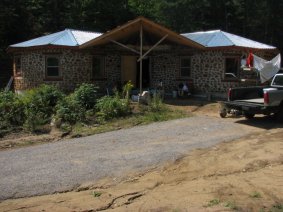 The Spec House
The Spec House |
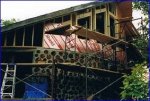 The Remodel
The Remodel |
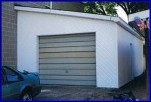 The Garage
The Garage |
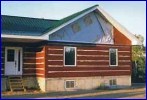 The Home
The Home |
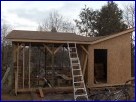 Woodshed and Shop
Woodshed and Shop |
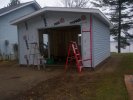 Another Garage
Another Garage |
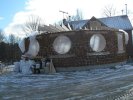 The Round House
The Round House |
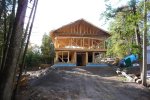 The Strawbale House
The Strawbale House |
| Home | New Stuff | Paintings | Guided Tour | Bio | Slide Shows | Links | Guestbook | Acquisitions © The images on these pages are protected under copyright law and all copyrights are reserved by the artist Chris Cooper. They are available on the WWW solely for the viewing pleasure of those who access these pages. Any other reproduction or retransmission of these images without the consent of Chris Cooper is strictly prohibited. CCOOPERART.COM© 2012 Chris Cooper |